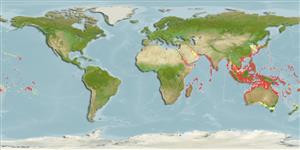Environment: milieu / climate zone / depth range / distribution range
Οικολογία
Θαλασσινό(ά); Υφάλμυρο Υφαλόφιλο(α); εύρος βάθους 3 - 58 m (Ref. 1602). Tropical; 36°N - 48°S, 24°E - 132°W
Indo-Pacific: Red Sea and East Africa eastward through Indonesia to Tuamotus, northward to southern Japan, southward to Lord Howe Island.
Μέγεθος / Βάρος / Age
Maturity: Lm ? range ? - ? cm
Max length : 120 cm TL αρσενικό/απροσδιόριστο; (Ref. 9710); common length : 54.0 cm TL αρσενικό/απροσδιόριστο; (Ref. 5450)
Ραχιαίες άκανθες (συνολικά): 0; Μαλακές ραχιαίες ακτίνες (συνολικά): 10-12; Εδρικές άκανθες 0; Μαλακές εδρικές ακτίνες: 10 - 11. Body covered with prickles (Ref. 559). Juveniles with dark stripes on belly, becoming spots with growth; adults with or without spots on fin (Ref. 4919).
Relatively uncommon in patch reefs and coral slopes near sandy areas of clear lagoon and seaward reefs. Juveniles occur in sandy and weedy inner reefs, adults on clear lagoons and seaward reefs (Ref. 9710). Juveniles inshore, usually on muddy substrates and often estuarine. Adults on deep slopes and range to outer reefs, sometimes swimming high above the substrate or just below the surface. Pelagic larvae may disperse over great distance and juveniles occur in subtropical zone (Ref. 48637). Enter estuaries (Ref. 4833). Considered as the giant among puffers reaching a total length well in excess of a meter.
Life cycle and mating behavior
Γεννητική Ωρίμανση | Αναπαραγωγή | Γεννοβολία | Αβγά | Γονιμότητα | Προνύμφες
Masuda, H., K. Amaoka, C. Araga, T. Uyeno and T. Yoshino, 1984. The fishes of the Japanese Archipelago. Vol. 1. Tokai University Press, Tokyo, Japan. 437 p. (text). (Ref. 559)
IUCN Red List Status (Ref. 130435)
Threat to humans
Poisonous to eat (Ref. 559)
Human uses
αλιεία: χωρίς ενδιαφέρον
Περισσότερες πληροφορίες
ΑναφορέςΥδατοκαλλιέργειεςΠροφίλ υδατοκαλλιέργειαςΣτελέχοιΓενετικήElectrophoresesΚληρονομικότηταΑσθένειεςΜεταποίησηNutrientsMass conversion
Εργαλεία
Special reports
Download XML
Διαδικτυακές πηγές
Estimates based on models
Preferred temperature (Ref.
123201): 22.4 - 29, mean 27.8 °C (based on 1224 cells).
Phylogenetic diversity index (Ref.
82804): PD
50 = 0.5000 [Uniqueness, from 0.5 = low to 2.0 = high].
Bayesian length-weight: a=0.04898 (0.03008 - 0.07974), b=2.86 (2.72 - 3.00), in cm total length, based on LWR estimates for this species & Genus-body shape (Ref.
93245).
Τροφικό Επίπεδο (Ref.
69278): 3.7 ±0.2 se; based on diet studies.
Ελαστικότητα (Ref.
120179): Χαμηλό, ελάχιστος χρόνος για διπλασιασμό πληθυσμού 4,5 - 14 έτη (Preliminary K or Fecundity.).
Fishing Vulnerability (Ref.
59153): High to very high vulnerability (72 of 100).
Nutrients (Ref.
124155): Calcium = 18 [7, 47] mg/100g; Iron = 0.429 [0.222, 0.944] mg/100g; Protein = 18.9 [16.7, 21.0] %; Omega3 = 0.102 [0.053, 0.196] g/100g; Selenium = 45.7 [22.5, 100.0] μg/100g; VitaminA = 28.6 [7.6, 110.0] μg/100g; Zinc = 0.832 [0.550, 1.275] mg/100g (wet weight);
